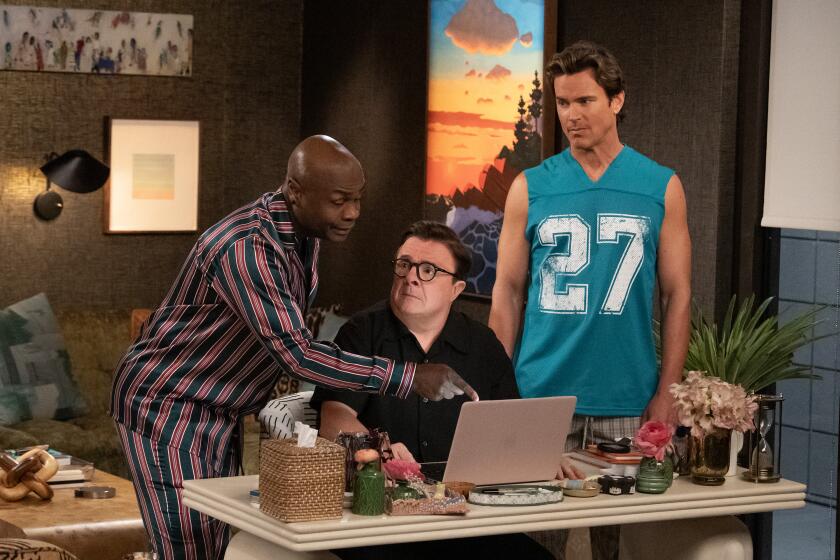‘Degrassi High’ Prize Winner at Banff TV Fest : Realistic Teen Series Tops Network Shows
- Share via
NEW YORK — When voting for the outstanding dramatic series on TV ended recently at the Banff Television Festival, it wasn’t any of the slick, big-name network shows such as “L.A. Law” or “thirtysomething” or the hit British soap opera “EastEnders” that emerged the winner, but a small, little-known production that usually finds itself in the children’s category at such events.
The prize winner, “Degrassi Junior High,” is, in fact, a children’s show. But it is one that portrays the problems of adolescents with a frankness that might startle even the adult audiences of its competitors at Banff.
The half-hour series, now in repeats on KCET Channel 28 in Los Angeles (weekdays at 5 p.m. through Aug. 19), follows in the serialized tradition of “Hill Street Blues” and other popular prime-time shows that carry over stories from episode to episode.
But, instead of depicting mid-life crises and thwarted career aspirations, “Degrassi Junior High” involves itself with the lives of teen-age characters caught up in the maelstrom of puberty.
“Degrassi’s” students grapple with drinking and drug abuse, the repercussions of shoplifting, the fallout from divorce, the gnawing insecurity that accompanies changes as major as puberty and as minor as getting a new pair of eyeglasses.
Such subject matter has the makings of wildly exploitative television. But the “Degrassi” production team, which includes two former junior high school teachers, has been lauded for its evenhanded treatment of controversial topics and its matter-of-fact approach to emotionally charged situations.
Last year, its first season, the series was endorsed by such organizations as the National Education Assn. and the American Assn. of School Administrators, and it earned an award from the consumer activist group Action for Children’s Television. It also received the 1987 International Emmy for best children’s show.
In the Banff competition, the six judges viewed two “Degrassi” episodes that chronicled the attempts of a pregnant teen-ager and her boyfriend to fathom the responsibilities of parenthood and portrayed the impact of the pregnancy on their families.
“It gave me as three-dimensional a picture of that situation as I have ever seen,” says the American judge, Laurence Bloustein, senior vice president at MTM Productions. “You saw the sheer, honest concern, caring and fear of that situation.
“For its intended audience, ‘Degrassi’ was focused, literate, spoke in the language of the kids who watch, and it made points. When a show sets out to do something and does it so well, it should win the award.”
Though still largely unheard of in the United States, “Degrassi Junior High” is the highest-rated Canadian-made drama in Canada, where it benefits from a nationally scheduled prime-time slot on the CBC as well as the audience’s familiarity with an earlier series made for 6- to 12-year-olds, “The Kids of Degrassi Street.”
“The Kids of Degrassi Street,” which aired in this country on The Disney Channel, won the Prix Jeunesse, the highest international honor in children’s television. But after making 26 episodes, the Canadian producers, former teacher Linda Schuyler and director Kit Hood wanted to move on to the more complex issues of adolescence.
Meanwhile, the lack of teen programming on American television had captured the interest of Kate Taylor, another ex-teacher who was associate director of children’s and cultural programming for PBS. Her company, Taylor Productions, joined with Skuyler and Hood’s Toronto-based Playing With Time to produce “Degrassi Junior High.”
Financial support for the show, which is in production for its second season, comes from Boston’s PBS station, WGBH, and Telefilm Canada.
“What we wanted to do was deal very boldly with the issues in kids’ lives, in a way they could be reassured that they were not alone,” says Skuyler, who is co-executive producer with Taylor. Hood directs most of the episodes. “We wanted to show them options in dealing with these problems but leave them enough room to make their own decisions. We knew these kids needed something. There was really nothing else out there for this audience.”
Teen-agers have long been considered one of TV’s hardest-to-please viewerships. By age, they make up a narrow audience, which is wildly diverse because of differing levels of maturity, interests and experiences.
Audience research done at WGBH indicates that “Degrassi” reaches its intended audience, on however small a scale. Last season, the series drew about 4 million viewers weekly, 40% of whom were under 18. Another 40% were adults under 50, suggesting that many parents and children watch the show together.
“It’s a real success because public television has had a hard time attracting teen-agers,” says Taylor. “It’s one of the very few shows that can entertain teens in a way like commercial television and that deals with the issues affecting their lives.
“A lot of the (commercial) network shows might touch on some of the issues, like teen pregnancy or peer pressure. But they don’t do it with the texture, the ambiguity, the complexity we are able to do it with. We’re not in a position where we have to have a happy ending, so we don’t have to tie things up at the end of each show.”
Taylor is surprised by the show’s acceptance in light of its honesty. The series airs in Great Britain, the Scandinavian countries, Australia, Germany and France and was just sold to China. In the United States, the series was carried by 290 PBS stations to more than 90% of homes, without creating much fuss or criticism.
“I really expected to hear by this time some complaints that the topics are too risque, that we deal with them in too risque a way,” she explains.
“I think people are realizing that with problems like teen pregnancy and drug abuse, and general issues like illiteracy, that we’ve gotten to a bit of a crisis point, that we have to get to those kids and teach them how to reason through these problems.”
More to Read
The complete guide to home viewing
Get Screen Gab for everything about the TV shows and streaming movies everyone’s talking about.
You may occasionally receive promotional content from the Los Angeles Times.






